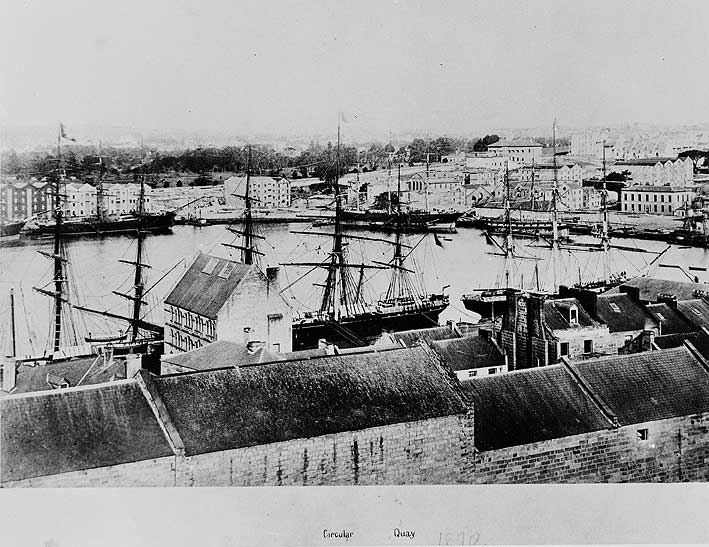Description
This is a photograph, from the series 'Cities and Towns - Sydney', of Circular Quay taken from The Rocks area in 1870. It shows bond stores and government buildings along the shores and sailing ships berthed in the harbour.
Educational value
- This asset shows Circular Quay in 1870 - between 1837 and 1844 a military officer of the Royal Engineers, Captain George Barney, had created a semicircular quay, building a seawall and employing thousands of convicts to reclaim about four and a half hectares of mudflats behind the wall; most of this fill came from the sandstone precipice dividing the two ends of Argyle Street, resulting in the Argyle Cut.
- It shows a busy Australian shipping port - in the 1850s shipping activities increased sharply as wool exports multiplied and gold discoveries were made; the quay was extended around its west bank and the semi circular quay become a full Circular Quay.
- It was taken from Cumberland Street, The Rocks, where the Cahill Expressway and the approaches to the Harbour Bridge now stand, across the roofs of houses on George Street; the modern Overseas Passenger Terminal fills the water where the closest ship is berthed in the picture.
- It shows the prominence at the time of the Sailors' Home, now the Visitors' Centre, shown to the left of centre in the middle ground of the picture; it was built on reclaimed land a safe distance from the water in 1864 by a committee of philanthropic citizens to provide sailors with affordable and comfortable board and lodgings as an alternative to the brothels and inns for which The Rocks was then renowned.
- It looks across the water to the Botanic Gardens, past the bond stores where the East Circular Quay development now stands - the traditional foundation date of the Botanic Gardens is 1816, when Mrs Macquarie's Road was completed; they were opened to the general public in 1831, when the Domain, west of Macquarie Street, was sold to pay for the construction of the new Government House and Circular Quay.
- It shows the roof of Cadman's Cottage just visible to the right of the picture - the oldest surviving residential house in Sydney, the cottage was built in 1816 and was occupied by Governor Macquarie's coxswain, John Cadman, and his family; in this picture, the cottage is beside the water, but through later land reclamation, the harbour is now 100 metres away.
- It shows at least six large sailing ships berthed in the Quay - sailing ships sailed along many sections of the Australian coastline, carrying goods, passengers and news.
- It was probably made using the wet collodion process, in which a wet negative was produced from a nitrocellulose (collodion) solution applied to a glass plate immediately before exposure.
- It demonstrates the dedication of photographers before significant developments in photography were made in the 1870s - the 'wet process' meant that a darkroom was needed wherever a photograph was to be made; some photographers took development tents with them; at this time, there were no enlargements, so if one wanted large prints, there was no alternative but to carry very large cameras.
